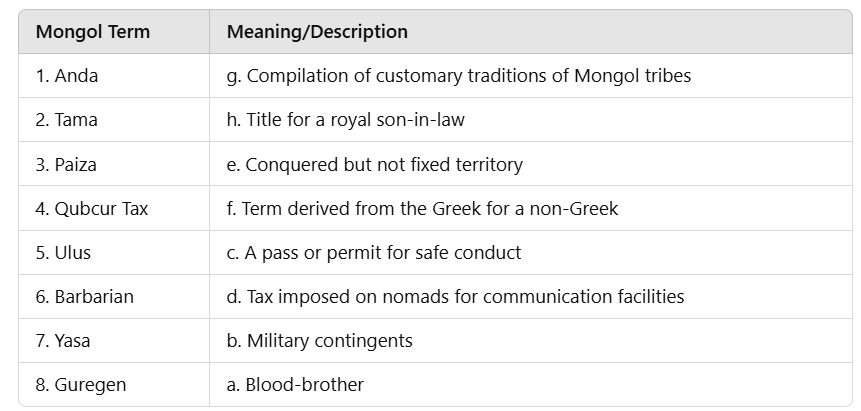Worksheet: Nomadic Empires | History Class 11 - Humanities/Arts PDF Download
| Table of contents |

|
| Fill in the Blanks |

|
| Match the Column |

|
| Assertion and Reason Based |

|
| Very Short Answer Type Questions |

|
| Short Answer Type Questions |

|
| Long Answer Type Questions |

|
Fill in the Blanks
Q1: The term "barbarian" is derived from the Greek word "__________," which meant a non-Greek.
Q2: The Great Wall of China was built to defend against nomadic invasions, particularly from the __________.
Q3: Genghis Khan was born near the __________ river in the north of present-day Mongolia.
Q4: Genghis Khan proclaimed himself as the "Universal Ruler" or "Great Khan" in the year __________.
Q5: The Mongol courier system known as "__________" connected distant areas of the empire.
Q6: "Yasa" served as a __________ code of Genghis Khan.
Q7: The administrative regulations, including the organization of the hunt and the army, were part of the "yasa" and helped integrate the __________ regions.
Q8: The tax levied on nomads for the maintenance of the Mongol communication system was known as the __________ tax.
Match the Column
Q1:

Assertion and Reason Based
Q1: Assertion: The term "barbarian" is derived from the Greek word "barbaros."
Reason: "Barbaros" referred to someone whose language sounded like a random noise.
(a) Both Assertion and Reason are true, and Reason is the correct explanation of the Assertion.
(b) Both Assertion and Reason are true, but Reason is not the correct explanation of the Assertion.
(c) Assertion is true, but Reason is false.
(d) Assertion is false, but Reason is true.
Q2: Assertion: The Mongol courier system was known as "yam."
Reason: It connected the distant areas of the Mongol empire.
(a) Both Assertion and Reason are true, and Reason is the correct explanation of the Assertion.
(b) Both Assertion and Reason are true, but Reason is not the correct explanation of the Assertion.
(c) Assertion is true, but Reason is false.
(d) Assertion is false, but Reason is true.
Q3: Assertion: Genghis Khan's "yasa" served as a code of law.
Reason: It was a compilation of customary traditions of Mongol tribes.
(a) Both Assertion and Reason are true, and Reason is the correct explanation of the Assertion.
(b) Both Assertion and Reason are true, but Reason is not the correct explanation of the Assertion.
(c) Assertion is true, but Reason is false.
(d) Assertion is false, but Reason is true.
Q4: Assertion: The tax levied on nomads for communication facilities was known as the "qubcur tax."
Reason: Nomads paid this tax willingly for the multiple benefits it brought.
(a) Both Assertion and Reason are true, and Reason is the correct explanation of the Assertion.
(b) Both Assertion and Reason are true, but Reason is not the correct explanation of the Assertion.
(c) Assertion is true, but Reason is false.
(d) Assertion is false, but Reason is true.
Very Short Answer Type Questions
Q1: What does the term "barbarian" mean, and where does it originate?
Q2: What was the primary purpose of the Great Wall of China?
Q3: When and where was Genghis Khan born?
Q4: What title did Genghis Khan proclaim himself in 1206?
Q5: What was the Mongol courier system known as, and what was its purpose?
Q6: What did "yasa" serve as, and what did it compile?
Q7: What tax did nomads pay for the maintenance of the Mongol communication system?
Q8: What was the significance of the term "guregen" in the Mongol context?
Short Answer Type Questions
Q1: Explain the reasons for the success of Genghis Khan's military campaigns.
Q2: What were the main features of Genghis Khan's political system, and how did it differ from Attila's?
Q3: How did the relationship between nomadic and settled societies affect trade and communication in the Mongol empire?
Q4: Discuss the administrative features of Genghis Khan's rule and the significance of "yasa" in Mongol society.
Long Answer Type Questions
Q1: Describe the social and political background of the Mongols during Genghis Khan's time.
Q2: Provide an overview of Genghis Khan's early life and the challenges he faced before becoming the Great Khan. How did he rise to power and unify the Mongol tribes?
Q3: Examine the impact of the Mongol Empire on Eurasian history, including its military conquests, administrative innovations, and the establishment of the Pax Mongolica. How did the Mongols facilitate cultural exchanges and trade along the Silk Road?
|
27 videos|125 docs|20 tests
|
FAQs on Worksheet: Nomadic Empires - History Class 11 - Humanities/Arts
| 1. What are the characteristics of nomadic empires? |  |
| 2. What are some examples of nomadic empires in history? |  |
| 3. How did nomadic empires impact settled civilizations? |  |
| 4. What factors contributed to the rise and fall of nomadic empires? |  |
| 5. How did the nomadic lifestyle of these empires shape their social and cultural structures? |  |
















